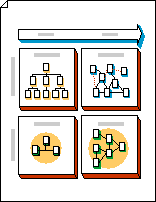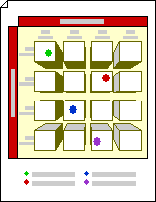Create a block diagram
This topic shows how to use the Block Diagram and the Block Diagram With Perspecitve templates.
Block diagrams use block and raised block shapes to brainstorm, plan, and communicate.

Block diagrams with perspective use 3-D shapes to convey information in a dramatic manner.

What do you want to do?
Create a block diagram
-
On the File menu, point to New, point to General, and then click Block Diagram.
-
From Blocks and Blocks Raised, drag shapes onto the drawing page.
-
To add text to a shape, select the shape and then type.
Make block shapes flow into one another
-
From Blocks, drag a 1-D single, 2-D single, or Open/closed bar shape onto the drawing page. Or, from Blocks Raised, drag a Right arrow, Up arrow, Left arrow, Down arrow, Horizontal bar, Vertical bar, or Elbow shape onto the drawing page.
-
Right-click the shape, and then click an Open command.
-
Place the open end of the shape against the flat side of another shape.
Tip: To position an open shape and hide lines, bring the open shape to the front. To change the order of selected shapes, on the Shape menu, point to Order, and then click Bring Forward or Send Backward.
Create a block diagram with perspective
The drawing page that opens with the Block Diagrams with Perspective template includes a vanishing point. When you drag a raised block shape onto this drawing page, the shape orients so that its perspective lines point to the vanishing point.
-
On the File menu, point to New, point to General, and then click Block Diagram with Perspective.
-
From Blocks With Perspective, drag shapes onto the drawing page.
-
To add text to a shape, select it, and then type.
-
To change the perspective of the shapes, drag the vanishing point (V.P.) on the drawing page to a new location, either on or off the drawing page.
Note: When you move a vanishing point, all the shapes associated with that point shift their orientation.
Tip: You can choose to hide or show depth while you work. On the View menu, click LayerProperties. In the 3D Depth row, under Visible, click to clear or display the check mark, and then click OK.
Orient a shape to a different vanishing point in a perspective diagram
You can orient shapes in a perspective diagram to different vanishing points.
-
From Blocks with Perspective, drag a new Vanishing point shape onto the diagram.
-
Select the shape you want to reorient.
-
Drag the red control handle
 from the center of the original vanishing point to the center of the new one.
from the center of the original vanishing point to the center of the new one.The connection between the shape and the vanishing point is glued when the control handle
 on the new vanishing point turns red.
on the new vanishing point turns red.
Note: When you add a new vanishing point to a perspective diagram, shapes on the page and shapes you add later continue to orient to the original vanishing point. Use these steps to reorient any shape to any vanishing point.
Change the depth of a block perspective shape
-
Right-click the shape you want to change, and then click Set Depth.
-
In the Depth list, click a percentage. The higher the percentage, the deeper your shape will appear.
Tip: To make the shadow color different from the shape's color, right-click the shape, and then click Manual Shadow. On the Format menu, click Fill, and then select a color for the shadow.
Delete a vanishing point from a perspective diagram
-
Right-click the vanishing point that you want to delete, and then click AllowDeletion.
-
Select the vanishing point, and then press the DELETE key.
Hide a vanishing point in a perspective diagram
-
On the View menu, click Layer Properties.
-
In the Vanishing point row, click the check mark under Visible to clear it, and then click OK.
Note: Even if you don't hide the vanishing point, it won't appear in a printed drawing.
No comments:
Post a Comment